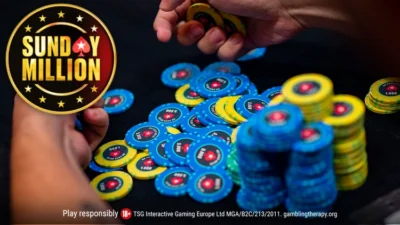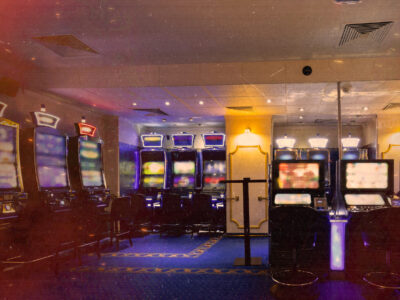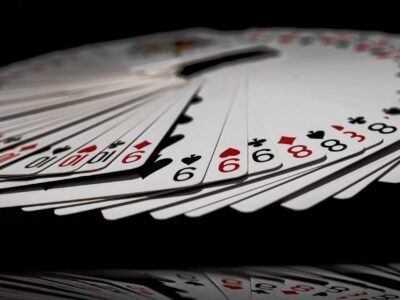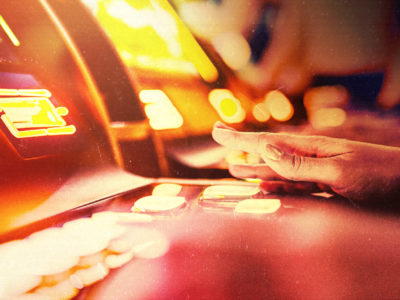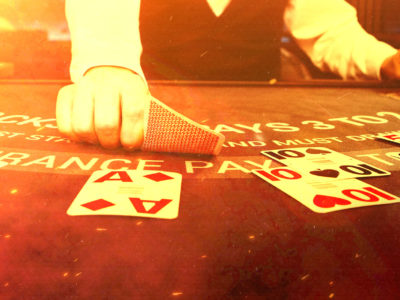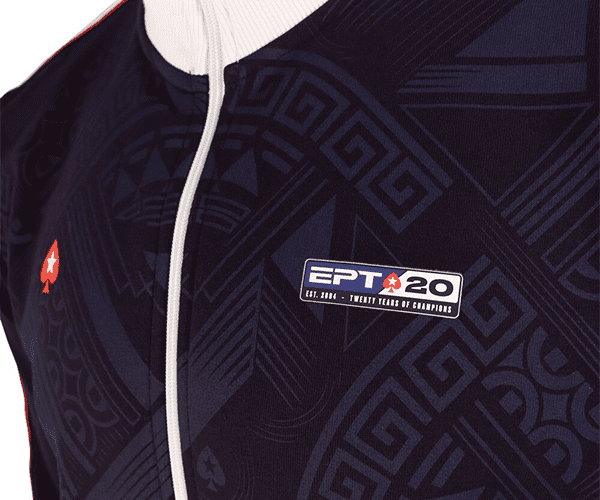Whether you’re a home-game host or the highest high roller, every player has handled hundreds of thousands of poker chips. They’ve been raked in, and sometimes (regrettably) been hauled away. But have you ever stopped to look closely at those small discs? Do you know how they’re designed? What they’re made of? And what’s inside them, keeping them safe?
Perhaps you can live your life without ever knowing. But if you’ve ever been curious, here’s all you need to know about poker chips, from the most basic plastic poker chip set, used for free, fun poker games in the kitchens and living rooms of the world, to the most advanced chips used for multi-million dollar bets in the VIP suites of Las Vegas, Macau and beyond.
The short version is that there’s much, much more to the humble poker chip than meets the eye.

Chip sculptures at UKIPT Marbella
Chips are the very tools with which poker players set their plans in motion. They are also how the same players while away the many dead hours at the tables: they’re for riffling and stacking in pretty towers and hopefully bagging at the end of the day. They need to be distinctively coloured, both to be aesthetically pleasing and for reasons of consistency and security. And manufacturers even take into account the sounds they make as they click-clack together, keeping customers happily gambling.
Most importantly they need to do their job: that is, to be reliable stand-ins for cash or tournament points, to be exchanged back when the time is right. They need to be solid and secure, of uniform size and thickness. It’s even more important at the casino tables outside the poker room, where each chip carries a cash value far higher than what it cost to produce.
THE MANUFACTURERS
If you’ve ever held a chip in a major casino, particularly if you’ve played table games other than poker, you’ve almost certainly been handling a product from of one of three companies: Abbiati, from Italy, Matsui, from Japan, or Gaming Partners International (GPI), originally a French company which has recently been acquired by the Japanese firm Angel. There are many other high-street outlets that produce the very cheapest chips — the thin, coloured plastic discs that might be blown away by a hefty belch — but when a casino wants the best, they essentially need to go to one of three places.

The patterns around a chip’s edges help ensure uniqueness of design
Each manufacturer has its own names for its various three or four core templates, each of which is customisable to varying degrees, and comes in sizes ranging from 39 millimetres in diameter to 48 millimetres. (The most common are 39mm and 43mm.)
The American market in particular likes the feel and pleasing sound of “clay” chips, which are not actually made of clay, rather a plasticine-like substance that is compressed and baked until it stiffens into something resembling plastic. Then there are so-called “injected” chips, which are typically plastic around the edge with a metallic inlay. These are injected with various coloured materials to give the distinctive patterns that can be seen around the edges of chips. These look like they are for decoration, but that’s only a small part of it.
Manufacturers will not sell an identical chip design twice, so the more parts of a chip that offers variation, the more possible overall combinations exist. When one can change mould, rim, inner/outer section of the chip, as well as add injects in up to 50 colours, uniqueness of design can be guaranteed. The manufacturers’ databases store details of previous designs and will flag up if a proposed combination has been made before. This allows one casino to know that its $100 denomination chip, for example, is not the same as another’s $1.
The inserts in the middle are added separately, and the design on them, a transfer known as a “decal”, is completely customisable with a particular client’s design. Some casinos favour simplicity, some use the decal as advertising space. Players sometimes spend a lot of time looking at the chips in their hands, so why not put details of the casino’s latest blockbuster show on there?

Customisable chips (designs from Matsui’s website)
The finishing touch on some chips, including the hundreds of thousands of printed ceramic chips used at PokerStars live events, is a slight roughness on the outer ring of the chip. If you examine this kind of chip under a microscope, that roughness actually appears like a landscape of tiny peaks. It helps the chips stick together slightly, and allows for better stacking.
SECURITY
By some measure, and for fairly obvious reasons, the most significant aspect of a poker chip is its security. In a casino, and more typically in games away from the poker tables, chips are ascribed a value far higher than their intrinsic value. It may only cost a few dollars to produce even the highest spec chips (and likely far less), but they very often carry a value many times higher, and frequently more even than the highest value denomination banknote in any country.
“It’s like a currency,” one industry insider told PokerStars Blog, describing how the factories that produce chips for the world’s biggest casinos are “like Fort Knox”. Chips are often manufactured and then shipped with the same level of security as bank notes. Only a select few security-vetted employees have access to the rooms at the heart of the operation, and the routes through which they are then transported are often kept secret. (The industry insider, who works for a chip manufacturer, spoke on the condition of anonymity.)
Much as in the murky world of currency counterfeiting, people have similarly attempted to manufacture fake chips and cash them in for their full value, else to sell them to dupes for a reduced price. A casino’s very existence might depend on the integrity of their chips.
The first step towards acquiring a secure chip is the selection of the manufacturer. A high-quality licensed company, such as the three listed above, will know all the tricks of the trade, recognise the importance of what they are producing and be equipped to sell products that adhere to all the most stringent guidelines.
Most significantly, the manufacturer needs to be able to produce chips that are identical to one another, with no variation in size, pattern or, more likely, inconsistencies in colour. “If all the chips are different, how can you spot a forgery?” the chip manufacturer said.

Let’s take a close look at some chips
These professional companies are then able to produce chips with any number of embedded security features. Most pit bosses, or poker tournament directors, will have a hand-held ultra violet (UV) light that they can shine over chips and which reflects off UV-sensitive material in the chip. This material is often formed into unique patterns on each chip, invisible to the naked eye, but which glows like a string of fairy lights when under UV light. It can come as quite a surprise to people who have spent hundreds of hours surrounded by poker chips to see a completely new pattern on apparently ordinary chips when the UV light is held over them.
The best analogy is the watermarks inside banknotes, visible when held up to the light, but otherwise easily overlooked unless they are being especially sought. The reflective material is both on the surface and the edges of the chips, so that their authenticity can be determined both while lying flat or in racks.
CHIPS WITH MICROCHIPS
The “ultimate security feature” in chips is radio-frequency identification, or RFID, which is becoming increasingly common in the highest denomination chips. In short, RFID technology works by embedding a tiny microchip into every chip, which can be read by a specially-equipped scanner. The microchip can attest not only to the authenticity of the chip, but can also detail what it’s worth, for which casino it was manufactured, where it came from, and potentially, in certain circumstances, even to which customer it was issued and how/when it was bet.

A few starting stacks at the PCA
The benefits for casino operators are numerous. With a scanner embedded beneath betting circles on table games, or beneath the centre of a poker table where chips in a a high-stakes cash-game pot might be positioned, the house can immediately determine not only whether the chips are authentic, but also the exact size of the bet or pot. This immediately eliminates the potential for human error, while also rooting out possible fake chips at the very moment they appear.
In combination with players’ loyalty cards in casinos, this also can keep track of the exact amount a certain customer is wagering, potentially triggering comps and bonuses. In the ultra-exclusive VIP gaming circles, agents fees, payable to junket operators dependent on how much business they can bring to casinos, can also be determined accurately and quickly.
FUTURE CHIPS
As ever, it’s these areas of a casino’s business that lead any push towards new technologies. This is where the greatest revenue is to be found, and where the inevitable instalment costs of new technologies can be most comfortably absorbed. But as services are streamlined and costs are reduced, the technology can spread to other areas of a casino’s business, and eventually possibly to the tournament poker room.
In a game played entirely with RFID-enabled chips, players’ stack sizes could conceivably be made available on digital displays, while pot sizes will be calculated accurately and immediately. This will help speed up games as players no longer need to ask “how much are you playing?” during every hand.
Taking the speculation further, it’s also entirely possible to then display a list of accurate, up-to-date chip counts for an entire tournament field in the poker room, or on an app. This would give players access to the kind of information always available in an online tournament lobby, but in a brick and mortar environment.
It’s bad news for the chip counters of the live updates team, who may need to go seeking alternative employment, but a useful tool to players and broadcasters, for whom such information will be highly valuable.
Back to TopView Other Blogs







